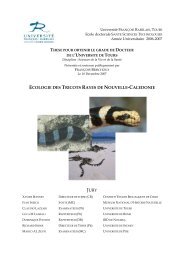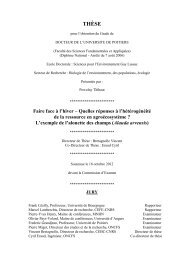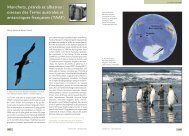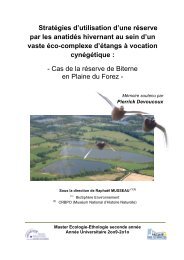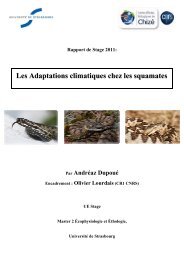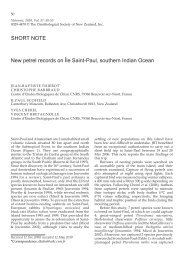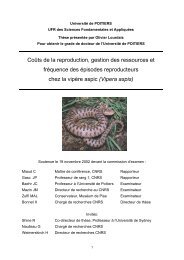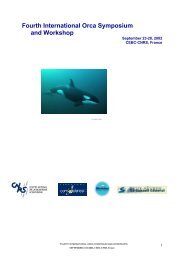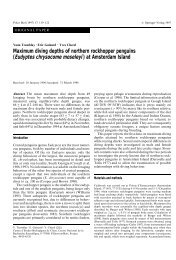Forçage environnemental et prédateurs marins ... - Cebc - CNRS
Forçage environnemental et prédateurs marins ... - Cebc - CNRS
Forçage environnemental et prédateurs marins ... - Cebc - CNRS
You also want an ePaper? Increase the reach of your titles
YUMPU automatically turns print PDFs into web optimized ePapers that Google loves.
690 CHRISTOPHE BARBRAUD AND HENRI WEIMERSKIRCH Ecology, Vol. 86, No. 3<br />
the framework of the selection hypothesis, which is<br />
supported by the results. First, there is evidence in the<br />
Blue P<strong>et</strong>rel that first-time breeders have a lower success<br />
probability mostly because their body condition is low<br />
compared to that of experienced breeders (Chastel <strong>et</strong><br />
al. 1995a). Secondly, the variations in breeding frequency<br />
are partly explained by variations in body condition,<br />
individuals in good condition breeding more<br />
frequently than those in poor condition (Chastel <strong>et</strong> al.<br />
1995b). Thus, the higher proportion of failed breeders<br />
among first-time breeders might reflect a higher proportion<br />
of individuals in poor condition (i.e., low-quality<br />
individuals). Given that the survival probability of<br />
first-time breeders was lower than the survival probability<br />
of inexperienced nonbreeders, these results suggest<br />
that selection might be operating on first-time<br />
breeders. The selection process on first-time breeders<br />
in year t implies that a higher proportion of high-quality<br />
individuals is present in year t 1. This is consistent<br />
with the low survival probability for first-time breeders<br />
during the winter in 1996 and 1997, followed by high<br />
probabilities of breeding in 1996 and 1997. Thus, a<br />
large fraction of the low-quality individuals was probably<br />
removed from the population, and the high-quality<br />
individuals that remained had a high probability of<br />
breeding during the following summers. Similar patterns<br />
were observed for inexperienced nonbreeders and<br />
experienced nonbreeders, suggesting that selection also<br />
operated to a lesser degree within these portions of the<br />
population. The survival probabilities of inexperienced,<br />
but not experienced, individuals are negatively<br />
affected by poor environmental conditions, which is<br />
consistent with the hypothesis of a high proportion of<br />
low-quality individuals among the segment of the population<br />
that never attempted to breed. The values of<br />
the slopes b<strong>et</strong>ween survival and SSH for each state<br />
suggest that selection probably operates strongly on<br />
inexperienced individuals and is weak or null on experienced<br />
ones.<br />
Because we estimated apparent mortality, which includes<br />
mortality and permanent emigration, the low<br />
apparent survival of inexperienced birds may also reflect<br />
high permanent emigration for individuals caught<br />
for the first time. We think that this is unlikely because<br />
no Blue P<strong>et</strong>rels banded in the study colony were captured<br />
outside the study colony during surveys on Mayes<br />
Island, although we cannot exclude the possibility that<br />
birds permanently emigrated to neighboring islands.<br />
Our results support the hypothesis of an influence of<br />
environmental conditions on life history traits and on<br />
the costs of reproduction as predicted by Erikstad <strong>et</strong><br />
al. (1998). First, survival probability for inexperienced<br />
individuals was correlated with environmental conditions.<br />
Second, the decrease in survival for first-time<br />
breeders was particularly pronounced during years with<br />
poor environmental conditions (1996 and 1997), suggesting<br />
that the costs of reproduction were enhanced<br />
during these years. In seabirds, the body condition of<br />
individuals d<strong>et</strong>eriorates during breeding due to the energ<strong>et</strong>ic<br />
costs of incubation (during which individuals<br />
fast on the egg) and chick rearing (when individuals<br />
forage at sea to feed the young) (Warham 1990). Inexperienced<br />
individuals in poor condition that faced<br />
poor food conditions during or after breeding probably<br />
could not restore their physical conditions and suffered<br />
higher mortality. This could be due to poorer foraging<br />
efficiency and lower skill of young inexperienced birds,<br />
as established for the Herring Gull Larus argentatus<br />
(Greig <strong>et</strong> al. 1983). Although our results indicate that<br />
survival probabilities for each segment of the population<br />
were not related to body condition, we think that<br />
this does not necessarily refute our hypothesis. Indeed,<br />
our covariate (body condition during breeding) might<br />
not have been appropriate, because body condition<br />
varies importantly throughout the year (Warham 1990).<br />
The relationships b<strong>et</strong>ween survival probabilities and<br />
SSH were strong and unequivocal (Fig. 4); SSH<br />
explained 88% of the variation in survival for firsttime<br />
breeders and inexperienced nonbreeders. This<br />
oceanographic variable seems to be a promising proxy<br />
of climate conditions when assessing the ecological<br />
effects of climate fluctuations on the population dynamics<br />
of seabirds, and perhaps marine mammals. It<br />
should be noted that the stratification of the studied<br />
population into breeding states clearly improved our<br />
understanding of the effect of environmental variability<br />
on survival.<br />
In conclusion, our results show that first-time breeders<br />
pay a cost of reproduction in terms of survival.<br />
Although it is considered difficult to demonstrate a<br />
reproductive trade-off using correlative data (Reznick<br />
1985), our results confirm those of Pyle <strong>et</strong> al. (1997)<br />
on the Western Gull Larus occidentalis, those of Tavecchia<br />
<strong>et</strong> al. (2001) on the Greater Flamingo Phoenicopterus<br />
ruber roseus, and those of Tavecchia <strong>et</strong> al.<br />
(2003) on Soay sheep Ovis aries, who also found costs<br />
of first reproduction for young individuals. It should<br />
be noted that age was not taken into account because<br />
we did not have information on age of the subjects,<br />
but that some of the ‘‘first-time breeder’’ effect may<br />
be due to age effects, as suggested by other studies<br />
(Pyle <strong>et</strong> al. 1997) in which first-time breeders paid a<br />
higher survival cost if they attempted to breed at a<br />
young age. First reproduction may act as a filter, selecting<br />
individuals of higher quality. The increase in<br />
survival with experience would correspond to a progressive<br />
disappearance of phenotypes of lesser quality,<br />
although the improvement of performance within individuals<br />
may contribute marginally to the observed<br />
patterns at the population level. Variation in sea surface<br />
height, reflecting food availability, in the winter following<br />
reproduction is probably a major factor of selection.<br />
The mortality among first-time breeders was<br />
particularly enhanced when food availability was low,<br />
indicating higher costs of reproduction during these<br />
years. Following these high-intensity selection events,



